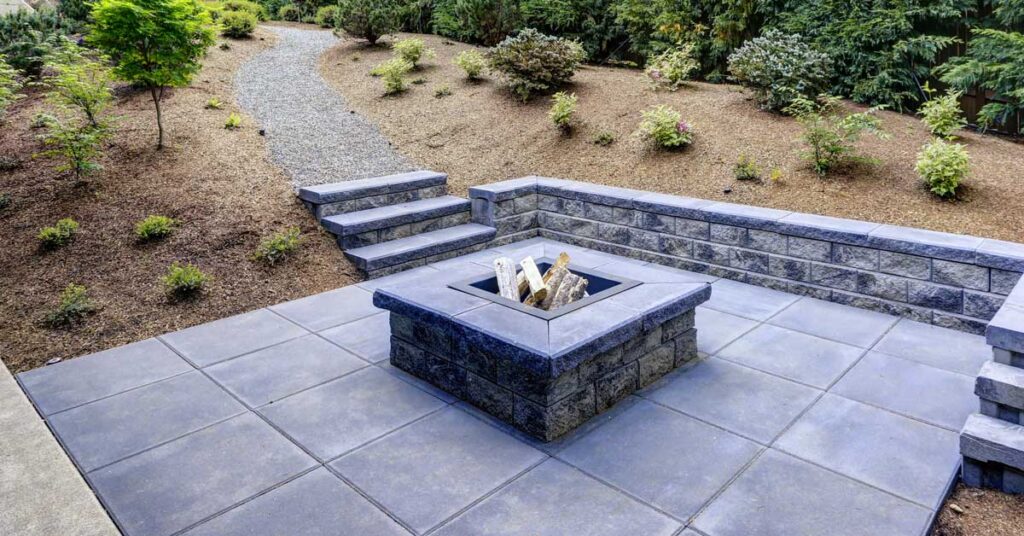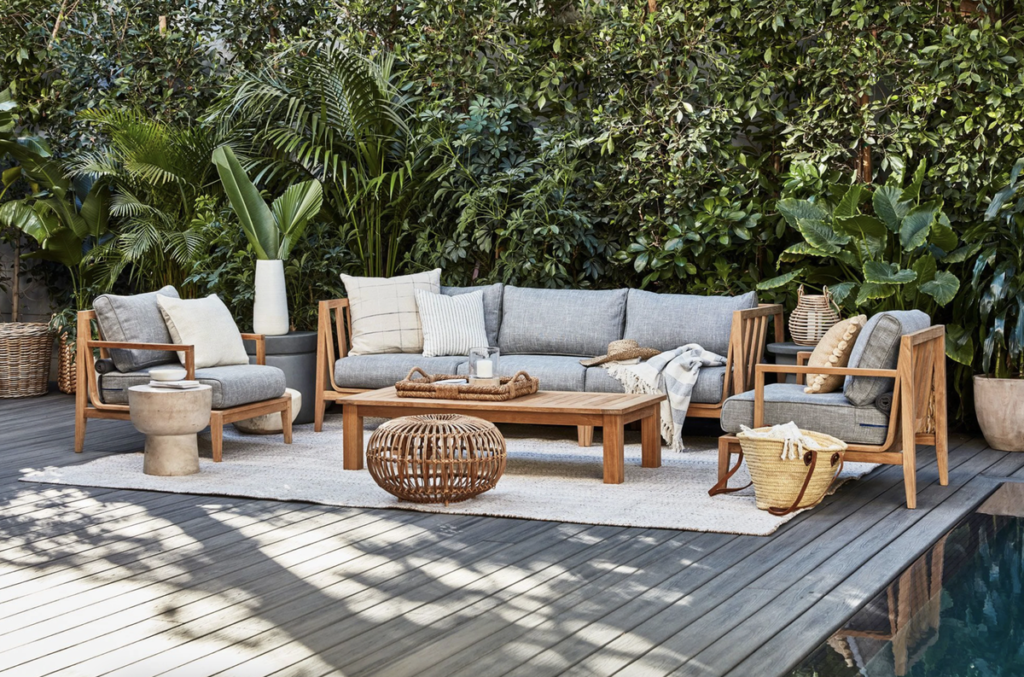What are patio awnings?
Patio awnings are a popular addition to outdoor living spaces. They are a type of shade structure that is designed to provide protection from the sun and rain. Patio awnings can be retractable or fixed, manual or motorized, and come in a variety of colors and fabrics to suit different styles and needs.
Retractable patio awnings are an excellent choice for those who want versatility and control over their outdoor space. They allow you to adjust the amount of shade and sunlight entering your patio by extending or retracting the fabric canopy. Retractable awnings can also be controlled remotely, making it easy and convenient to adjust the shade and protection as needed.
Fixed patio awnings, on the other hand, provide permanent shade and protection from the elements. They are a great option if you want a more permanent addition to your outdoor living space and don’t need the flexibility of retractable models.
Patio awnings come in a range of materials, including metal, aluminum and water-resistant fabric. Some models have rain sensors to close the awning automatically during inclement weather. This eliminates the need to manually adjust the awning and protects outdoor furniture from water damage.
Patio awnings are a good investment if you want to protect your outdoor furniture and create a shaded area for relaxing or entertaining. They can also help reduce energy costs by blocking direct sunlight and reducing the need for air conditioning. Additionally, some models are designed to withstand heavy snowfall and harsh weather conditions, ensuring long-term durability and protection.
In conclusion, patio awnings are a versatile and practical addition to your outdoor living space. They provide shade, protection and energy savings, and are worth considering if you want to enhance your outdoor experience.
What benefits do they provide?
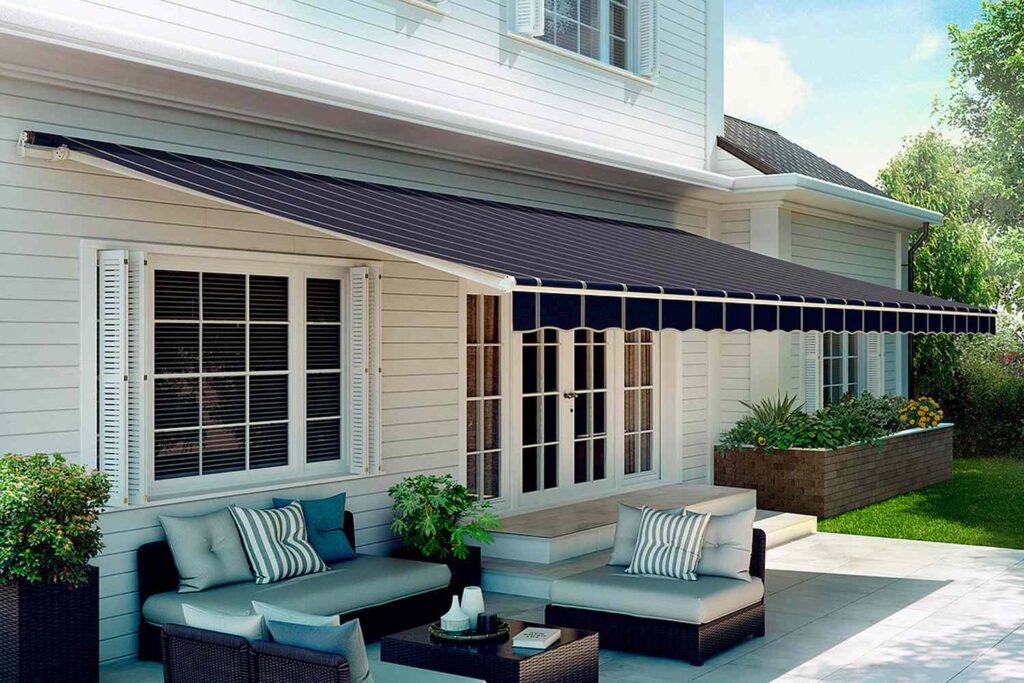
If you’re looking to enhance your outdoor living space, consider installing a patio awning. Not only do they provide shade and protection from the elements, but they also offer a range of benefits that can make your outdoor area more comfortable and enjoyable.
One of the primary benefits of patio awnings is their versatility. With retractable models, you can easily adjust the amount of shade and sunlight entering your patio to create the perfect atmosphere for relaxation or entertaining. If you need more protection from the sun or rain, simply extend the fabric canopy. If you want more natural light, retract it to enjoy the sun’s rays without direct exposure.
In addition to their flexibility, patio awnings can also help reduce energy costs. By blocking direct sunlight, they keep your patio cooler and reduce the need for air conditioning. This can result in significant savings on summer cooling costs.
Patio awnings are also a great investment in the longevity of your outdoor furniture. They protect your furnishings from fading, water damage, and other environmental factors. This, in turn, reduces the need for costly repairs or replacement.
And if you live in an area with harsh weather conditions, patio awnings are particularly beneficial. High-quality retractable awnings can withstand heavy snowfall and inclement weather, ensuring long-term durability and protection. Additionally, some models have rain sensors that close the awning automatically during bad weather, eliminating the need for manual adjustments and preventing water damage.
Finally, patio awnings offer a wide selection of styles, colors, and fabric options to choose from so you can customize your outdoor space to your liking. Whether you prefer aluminum or water-resistant fabric, you can find the perfect match to complement your patio furniture and overall style.
In conclusion, patio awnings provide numerous benefits that make them a worthwhile investment for any outdoor living space. From flexibility and energy savings to protection and style options, there are many reasons to consider installing a patio awning.
Initial Cost
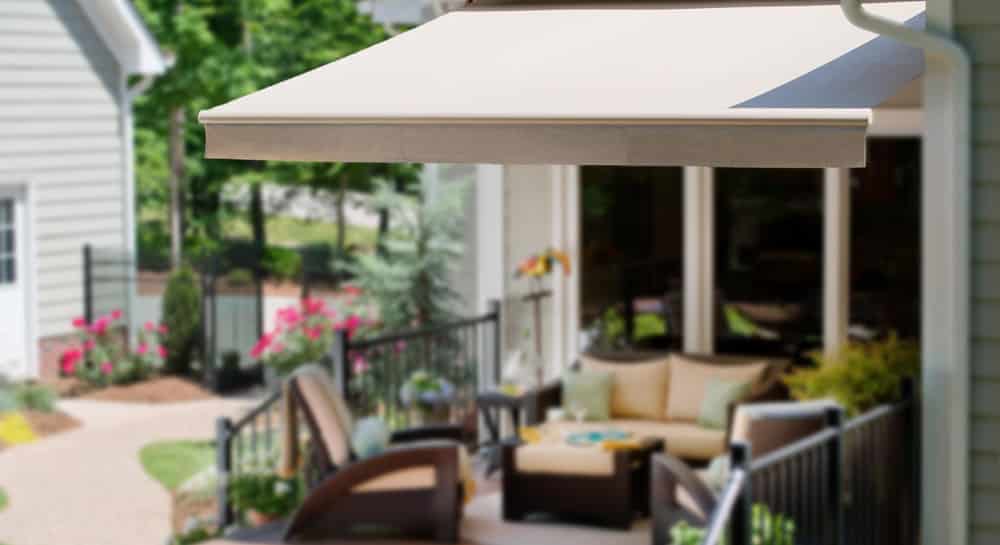
When it comes to investing in patio awnings, one of the most important factors to consider is the initial cost. While many people may balk at the price tag of a high-quality retractable awning, it’s important to take a long-term perspective when making a purchase.
At first glance, it’s easy to assume that non-retractable or permanent awnings would be the most cost-effective option. After all, they require less hardware and installation time, which may make them seem like a better bargain in the short run.
However, when you consider the benefits of a retractable awning – such as the ability to adjust the amount of light and shade, or the convenience of a motorized option – the initial cost becomes much more reasonable.
In fact, many homeowners find that investing in a high-quality retractable patio awning pays for itself in energy savings over time. By reducing the amount of direct sunlight that enters your home, you may be able to reduce your reliance on air conditioning or other cooling methods during the summer months.
It’s also worth noting that most patio awnings are built to last for many years, reducing the need for frequent repairs or replacements. A durable, well-made awning can protect your outdoor furniture and help you create a comfortable, inviting atmosphere for your family and guests.
When considering the initial cost of a patio awning, it’s important to remember that you’re making an investment in the long-term value and enjoyment of your home. By choosing a reliable, well-made awning and taking care to install it correctly, you’ll be able to enjoy shade, protection, and style for years to come.
Price of Motorized vs. Manual Awnings
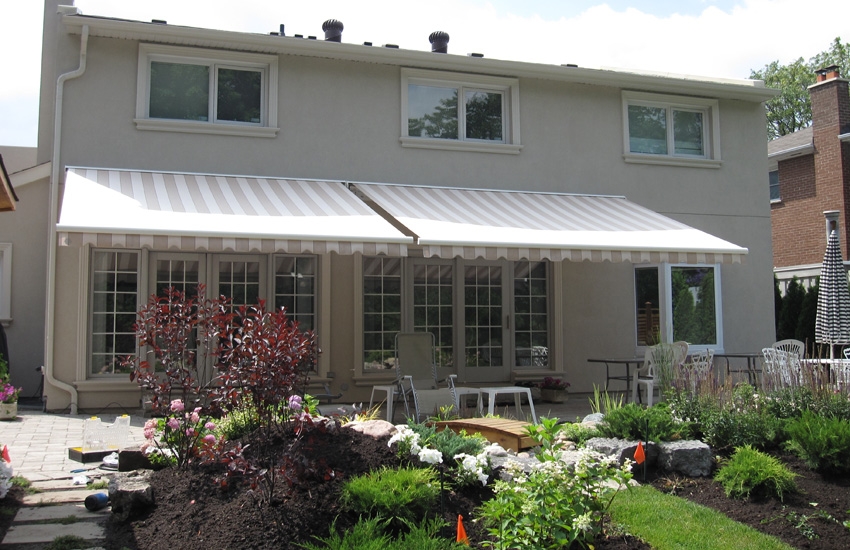
If you’re in the market for a new patio awning, one of the major decisions you’ll need to make is whether to invest in a motorized or manual option. While motorized awnings offer the convenience of remote control operation, they also come with a higher price tag compared to their manual counterparts. But is the added cost worth it? Let’s take a closer look at the price of motorized vs. manual awnings.
Manual awnings tend to be the more budget-friendly option. They typically require less hardware and installation time, which translates to lower labor and material costs. Additionally, since manual awnings don’t come equipped with a motor and remote control, there are fewer expensive components to factor in. Depending on the size and type of manual awning you choose, prices can range from a few hundred to a few thousand dollars.
On the other hand, motorized awnings offer a level of convenience that can be hard to beat. With the touch of a button, you can easily retract or extend your awning as needed. This can be especially beneficial for larger or higher-up units that might be difficult to operate manually. However, with added convenience comes added cost. Motorized awnings may require more hardware and installation time, and the motor and remote control components can be pricey. As a result, depending on the size and features of the awning, motorized options can cost anywhere from a few thousand to several thousand dollars or more.
So, which option is right for you? Ultimately, it depends on your priorities and budget. If you’re looking for a more wallet-friendly solution and don’t mind the extra effort of manually retracting and extending your awning, then a manual option might be the way to go. However, if you’re willing to spend a bit more for the convenience of remote control operation and easy adjustment, a motorized awning might be worth the investment. Just be sure to factor in all of the associated costs before making a decision.
Potential Savings from Energy Costs

When it comes to outdoor living spaces, one of the biggest concerns for homeowners is energy costs. With the summer sun beating down and temperatures soaring, it can be a real challenge to keep things cool and comfortable without running up your energy bill. But did you know that investing in a patio awning can actually save you money in the long run?
One of the biggest benefits of a retractable patio awning is its ability to reduce energy costs. By providing much-needed shade, awnings can help keep your outdoor space cool and comfortable even on the hottest days. This means you’ll be less likely to rely on your air conditioning system, which in turn can lead to significant energy savings.
In fact, according to some estimates, a well-placed awning can reduce solar heat gain by up to 77%. This means you’ll be able to enjoy your outdoor space without worrying about the harsh rays of the sun beating down on you and your guests. And since you won’t be running your air conditioner as often, you’ll be able to save money on your energy bills.
But it’s not just the heat that a patio awning can help to control. During rainy seasons, retractable awnings can also help to keep your patio furniture protected from water damage and heavy rain. This means you’ll be able to enjoy your outdoor living space more often, without having to worry about replacing furniture damaged by the elements.
Of course, it’s worth noting that the initial cost of a patio awning can vary depending on the type and features you choose. However, when you consider the potential savings from energy costs and furniture replacement, it’s clear that purchasing an awning can be a wise investment in the long run.
In addition to reducing energy costs and protecting your furniture, a patio awning can also increase your home’s value and curb appeal. With a variety of colors and fabric options to choose from, you can find the perfect awning to complement your home’s style and architecture.
In conclusion, if you’re considering investing in an outdoor living space or are looking for ways to reduce your energy costs, a patio awning is definitely worth considering. Whether you opt for a motorized or manual awning, the potential savings from energy costs and furniture replacement make it a wise investment for any homeowner.
Variety of Colors and Styles

One of the biggest advantages of getting a patio awning is the wide range of colors and styles available in the market. With so many options to choose from, property owners can easily find the perfect awning to match the architectural design and color scheme of their home or business establishment.
From traditional patio awnings in earthy hues to modern retractable awnings in sleek and bold colors, the possibilities are endless. Vibrant and bright colors can add a pop of color to an otherwise dreary outdoor space, while more neutral tones can provide a soothing and classic look.
Not only can you choose from a wide variety of colors, but you can also select from different materials, shapes, and styles. For instance, metal awnings are an excellent choice for homeowners who want a minimalist and modern design, while canvas awnings are perfect for those who prefer a more traditional and cozy feel.
If you want to take your outdoor living space to the next level, a motorized awning can be a perfect addition. These awnings can be conveniently controlled using a remote, making it easy to extend and retract them as needed.
Another fantastic feature of patio awnings is the availability of rain sensors. These sensors can automatically retract the awning as soon as it starts raining, keeping it protected from damage. Some awnings also come with additional features like wind sensors that can help it withstand inclement weather conditions.
In summary, patio awnings come in various styles, colors, and materials, giving customers the ultimate freedom to customize their outdoor space. With so many options, property owners can easily find the perfect awning to suit their needs while adding value and aesthetic appeal to their property.
Different Types of Materials Used for Awnings

Awnings are a great way to add beauty and functionality to any outdoor space, and they also provide much-needed shade and protection from the sun’s harmful rays. However, when it comes to selecting the right awning, there are various materials to choose from, each with its own set of benefits and drawbacks. In this article, we will explore the different types of materials used for awnings to help you make an informed decision.
1. Canvas: Canvas is a popular material for awnings due to its durability and versatility. It is available in a variety of colors and patterns, which makes it easy to match with your outdoor décor. Canvas is also water-resistant and can withstand harsh weather conditions, making it perfect for outdoor use.
2. Vinyl: Vinyl is another popular material for awnings, especially for those looking for a more cost-effective option. It is easy to clean, and its water-resistant properties make it ideal for areas with heavy rainfall. However, vinyl awnings may not hold up well in harsh weather conditions like high winds or heavy snowfall.
3. Acrylic: Acrylic awnings are a popular alternative to canvas. They are lightweight, which makes them easy to install, and they come in a wide range of colors and patterns. Acrylic is also resistant to fading, mildew, and mold, which makes it a great option for areas with high levels of humidity.
4. Aluminum: Aluminum awnings are highly durable and long-lasting, making them an excellent choice for homeowners who want a permanent awning. They are also lightweight, which makes them easy to install and maintain. The only downside of aluminum awnings is that they may not provide as much shade as other materials due to their lightweight nature.
5. Polycarbonate: Polycarbonate awnings are a great alternative to traditional fabric awnings. They are made of durable, shatter-resistant plastic and can withstand heavy snowfall and rainfall. They offer a modern and sleek look that is perfect for contemporary homes. However, they do not provide as much shade as traditional fabric awnings.
In conclusion, selecting the right material for your awning is crucial to ensure it provides the desired functionality and style. Factors like durability, water resistance, and ease of maintenance should be considered when selecting the material that best suits your needs. By understanding the different types of materials used for awnings, you can make an informed choice that will provide years of functional and aesthetic benefits.
Unique Designs to Complement Your Home’s Exterior Design

Your home’s exterior design is the first thing people see when they approach your property. It’s an opportunity to create a welcoming environment that’s an accurate representation of your personal style. From the color of your front door to the style of your windows, every detail of your home’s exterior contributes to making a great first impression.
One way to take your exterior design to the next level is by incorporating unique awning designs that complement your home’s aesthetic. Awnings not only add architectural interest to your property, but they can also provide functional benefits such as shade and protection from inclement weather.
Here are some unique awning designs to consider that can complement your home’s exterior design:
1. Custom-Cut Shapes: Awnings don’t always have to be traditional rectangles or squares. Custom-cut shapes can be made to fit your specific architecture and add a one-of-a-kind touch to your home’s exterior.
2. Textured Fabrics: Instead of standard canvas or vinyl, consider textured fabrics such as sailcloth, linen, or tweed. These materials can add dimension and depth to your awnings while also providing a unique look.
3. Modern Metal: For a contemporary aesthetic, metal awnings can make a statement. Aluminum or stainless steel cables can be used to create sleek, modern designs that are both functional and visually appealing.
4. Custom Colors: Awnings are available in a wide range of colors, but custom colors can take your exterior design to the next level. Choosing a color that contrasts or complements your home’s siding can add interest and style.
5. Wood-Frame Awnings: If your home has a more traditional or rustic style, consider wood-frame awnings. These awnings add warmth and texture to your home’s exterior and can be stained or painted to match your home’s trim.
No matter what type of unique awning design you choose, it’s essential to consider the overall style and color scheme of your home’s exterior. Your awnings should complement, not detract, from the overall aesthetic. With the right awning design, you can create a welcoming environment and elevate your home’s exterior design.
Rain and Heavy Snowfall Protection
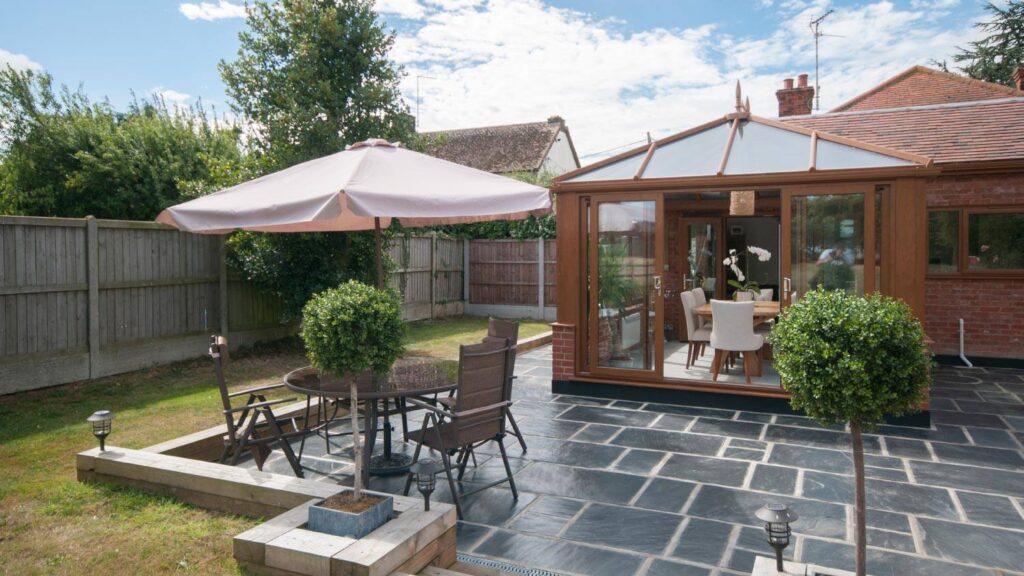
Patio awnings can be a great addition to your outdoor living space, not only for their aesthetic value but also for their functionality and protection. Rain and heavy snowfall can be a major concern when it comes to protecting your outdoor furniture and extending the life of your patio space. Awnings provide a great solution to protect your outdoor space from the elements.
One of the main benefits of patio awnings is their ability to protect your outdoor furniture from water damage. Water-resistant fabric is used to cover the awning, which allows rainwater to simply roll off the material, instead of getting trapped and potentially damaging your furniture. Even light rain can pose a risk of water damage, especially to wooden furniture. Awnings keep your furniture dry and protected from moisture, which can shorten its lifespan.
Another benefit of a patio awning is that it can protect your outdoor space from heavy snowfall during the winter months. Heavy snowfall can lead to the accumulation of snow on your outdoor furniture, as well as on the awning itself. Too much weight from heavy snow can damage your furniture, and even lead to a collapsed awning. However, if you have a durable awning, it can withstand heavy snowfall and prevent any damage to your outdoor furniture.
One thing to keep in mind is that not all awnings are created equal when it comes to heavy rain or snowfall protection. Non-retractable awnings are designed to be fixed in place, and are not adjustable in response to changing weather conditions. Permanent awnings, while offering good protection, can be more expensive and may not always be suitable for all patio designs.
Retractable patio awnings offer the best of both worlds, combining protection from the elements with flexibility. You can adjust the awning according to the weather conditions, using a remote control or a motorized system. In addition, retractable awnings can also provide energy savings, as they help keep your home cooler during the hot summer months, reducing your summer cooling costs.
When choosing a patio awning for rain and heavy snowfall protection, there are several factors to consider. Look for awnings with rain sensors, which automatically retract when it detects rain or other inclement weather. Choose an awning made from durable materials that can withstand harsh weather conditions, such as galvanized steel or marine grade stainless steel. Also, consider the type of fabric used, as some fabrics are better suited for heavy rain and snow protection than others.
In conclusion, patio awnings are a valuable investment if you’re looking to protect your outdoor living space from heavy rain and snowfall. Consider all your options, including fixed and retractable awnings, and choose an awning that will offer protection from the elements while also complementing your outdoor space. Not only will it protect your furniture and outdoor decor, but it will also provide a place to relax and enjoy the natural light without being exposed to direct sunlight or precipitation.
Water-Resistant Fabric Options and Rain Sensors
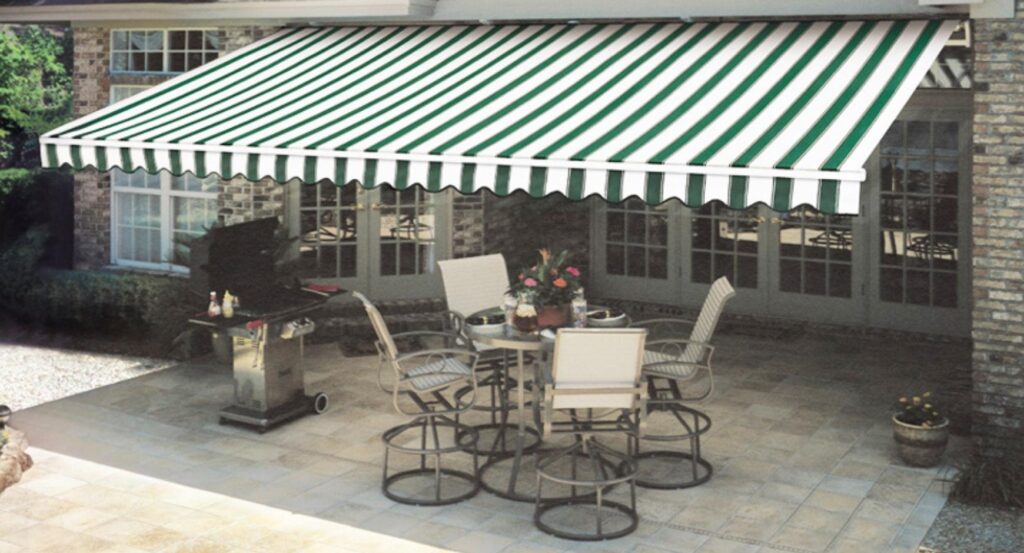
When it comes to choosing a patio awning that can provide effective rain protection, the material of the fabric used is an important consideration. Water-resistant fabric options are designed to repel water, ensuring that rainwater simply rolls off the material without penetrating it. This helps to keep your outdoor furniture dry and protected, even during heavy downpours.
One popular water-resistant fabric option is acrylic fabric. This type of fabric is designed to resist fading, mildew, and water damage, making it an ideal choice for outdoor applications. Acrylic fabric is also available in a wide range of colors and patterns, so you can choose an awning that complements the style of your patio perfectly.
Another water-resistant fabric option is vinyl-coated polyester fabric. This fabric is both waterproof and highly durable, making it an excellent choice for areas with heavy rainfall or snowfall. Vinyl-coated polyester fabric is also resistant to UV radiation, ensuring that it does not fade or degrade over time.
Aside from water-resistant fabrics, the installation of a rain sensor is another important feature to consider. Rain sensors can detect when rain or other forms of precipitation are falling, and automatically retract the awning to prevent any water damage. This not only helps to protect your outdoor furniture from being drenched, but also prolongs the lifespan of your patio awning.
Awnings with rain sensors are available in both motorized and manual options. Motorized awnings have built-in sensors that detect precipitation and adjust the position of the awning accordingly. Manual awnings, on the other hand, use an add-on device that detects rain and signals to the user to retract the awning manually.
In conclusion, choosing an awning with a water-resistant fabric and a rain sensor is crucial for ensuring that your outdoor space is protected from the elements. Whether you opt for acrylic fabric, vinyl-coated polyester, or another type of water-resistant fabric, ensuring that your awning is equipped with a rain sensor can prevent costly water damage to your furniture and prolong the life of your patio awning.
Inclement Weather Considerations
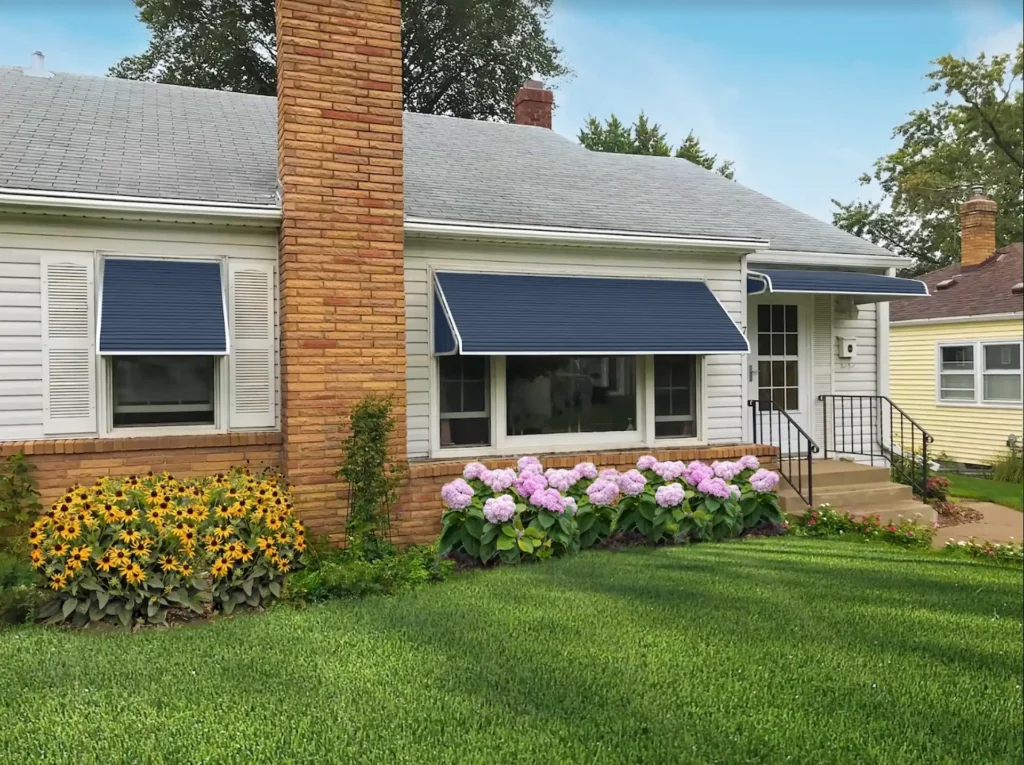
When it comes to patio awnings, one important consideration is how they hold up during inclement weather. While awnings can provide valuable shade and protection from the sun, they may not be able to withstand harsh weather conditions. Here are a few things to keep in mind:
1. Heavy rain: While many patio awnings are water-resistant, heavy rain can still cause issues. If water pools on the awning, it may sag or even collapse under the weight. To prevent this, make sure to choose an awning with a slope or pitch that encourages water to run off quickly. Alternatively, consider installing a rain sensor that can automatically retract the awning during heavy rainfall.
2. Heavy snowfall: Similar to heavy rain, heavy snowfall can also cause an awning to collapse under the weight. If you live in an area with harsh winter weather, it’s important to choose an awning that is specifically rated for snow load. Additionally, be sure to keep the awning clean and free of snow buildup to prevent any damage.
3. Wind: Strong winds can pose a threat to patio awnings, especially if they are not properly secured. Make sure your awning is installed with high-quality materials such as galvanized steel or stainless steel cables. Additionally, choose an awning with a wind sensor that can automatically retract the awning during gusty conditions.
4. Sun exposure: While not technically inclement weather, exposure to direct sunlight can also have an impact on the lifespan of your patio awning. Look for awnings made with high-quality, UV-resistant materials to prevent fading and degradation over time.
Ultimately, the type of awning you choose will depend on your specific needs and location. Consider the climate and weather patterns in your area and choose an awning that is designed to hold up under those conditions. With the right awning, you can enjoy your outdoor living space in comfort and style, no matter the weather.
Perfect Awning for Outdoor Living Spaces
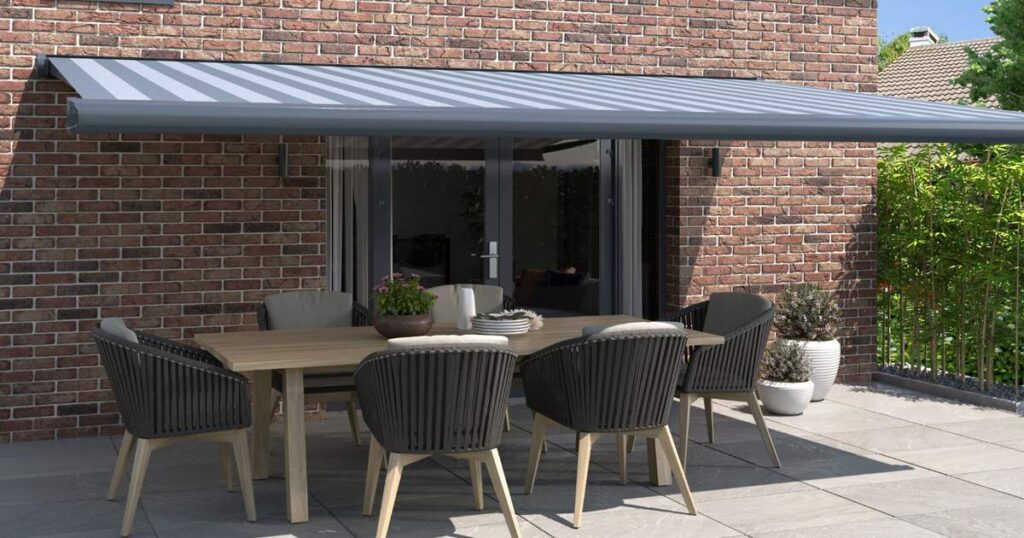
When it comes to designing the perfect outdoor living space, there are a lot of factors to consider. From choosing the right patio furniture to selecting the ideal landscaping elements, creating an inviting and functional outdoor area can take a lot of time and effort. However, one element that should not be overlooked is the addition of a high-quality patio awning.
Not only do patio awnings provide much-needed shade during hot summer days, but they can also protect your outdoor furniture from the elements and increase the overall aesthetic appeal of your space. Whether you’re looking for a manual awning or a motorized retractable option, there are plenty of styles and features to choose from to match your specific needs and preferences.
One important factor to consider when selecting a patio awning is the level of durability it offers. This is particularly important if you live in an area with harsh weather conditions such as heavy rain or snow. Look for awnings made with durable, weather-resistant fabrics and materials such as aluminum or galvanized steel to ensure your investment is protected for years to come.
Another key consideration is the aesthetic appeal of the awning. You want to choose an option that complements the style and design of your outdoor space. Fortunately, there are a wide variety of colors and patterns available to help you find the perfect match.
In addition to traditional manual awnings, there are also plenty of high-tech options available, such as motorized retractable awnings that can be controlled with a remote or smartphone app. Some models even come equipped with rain sensors that can automatically retract the awning during inclement weather, providing an added layer of protection for your outdoor space.
Overall, a high-quality patio awning is a must-have element for any outdoor living space. With the right option, you can enjoy your outdoor area comfortably and confidently, no matter the weather or time of day.
Potential Buyers’ Perspectives
When it comes to purchasing a patio awning, there are a variety of perspectives that potential buyers may take into consideration. From energy savings to aesthetics, here are some common perspectives that may influence a buyer’s decision:
1. Energy Savings: One of the most significant benefits of patio awnings is their ability to reduce energy costs. By providing shade and blocking direct sunlight, awnings can keep your outdoor living space cooler, lessening the need for air conditioning and ultimately reducing your energy bill. This perspective may be particularly appealing for buyers looking to lower their overall environmental impact and save money on utility costs.
2. Aesthetics: Patio awnings come in a variety of colors, patterns, and styles, making them a great way to add an element of design to your outdoor space. Buyers who prioritize aesthetics may want to focus on finding an awning that complements the existing décor, such as matching the color to the patio furniture or choosing a pattern that complements the landscaping.
3. Protection from the Elements: Another common perspective for potential buyers is the desire for protection from the elements. This may include protecting outdoor furniture from sun and rain damage or creating a dry space for outdoor entertaining during inclement weather. Retractable and permanent awnings can both provide protection, with some retractable models even offering rain sensors to automatically retract in bad weather.
4. Durability: For buyers looking for a long-lasting investment, the durability of the awning may be a priority. Options made from high-quality materials such as marine-grade stainless steel cables and heavy-duty fabrics can offer increased durability. This perspective is particularly important for buyers living in areas with harsh weather conditions such as heavy rain or snow.
5. Cost: Of course, cost is a factor that cannot be overlooked. While patio awnings can range in price depending on the size, material, and additional features, there are options available at a reasonable price. Buyers may want to compare the initial cost of a retractable awning to the potential money saved on energy costs in the long run.
Ultimately, the perspective that resonates most with a potential buyer will depend on their individual needs and preferences. By weighing these different perspectives and options, buyers can choose an awning that not only meets their functional needs, but also enhances their outdoor living space in a unique and personalized way.
Conclusion
When it comes to deciding if a patio awning is worth the investment, there are a variety of perspectives to consider. From energy savings to protection from the elements, aesthetics to durability, the benefits of a patio awning are numerous.
For those looking to reduce their environmental impact and save money on energy costs, a patio awning can provide significant savings. By blocking direct sunlight and keeping outdoor living spaces cooler, awnings can lessen the need for air conditioning and ultimately reduce energy bills.
From a design standpoint, patio awnings offer a wide variety of options, allowing buyers to match the awning to their existing décor or landscaping. And in terms of protection from the elements, retractable and permanent awnings can both offer a dry space for outdoor entertaining during inclement weather or protect outdoor furniture from sun and rain damage.
For buyers concerned with durability, high-quality materials such as marine-grade stainless steel cables and heavy-duty fabrics can offer increased longevity. And while the initial cost of a patio awning may be a concern, considering the potential money saved on energy costs in the long run can help make the decision a more sound investment.
Overall, the benefits of a patio awning make it a worthwhile investment for those looking to enhance their outdoor living space and protect their investment. Whether it’s providing shade and reducing energy costs, adding a design element, or protecting from the elements, a patio awning offers a variety of advantages and is worth considering for any outdoor living space.
Summary: Are Patio Awnings Worth It?
Are Patio Awnings Worth It? This is a question many potential buyers ask when considering whether to invest in an awning for their outdoor living space. But with a variety of options available, from retractable to permanent and a range of materials and colors to choose from, the benefits of patio awnings are hard to ignore.
From an environmental and cost-saving perspective, patio awnings are a smart choice. By blocking direct sunlight and providing much-needed shade, awnings can help reduce cooling costs during the hot summer months. In turn, this can lead to significant energy savings over time, as less air conditioning is required to maintain a comfortable living space.
In addition to energy savings, patio awnings can also provide protection from the elements. Whether it’s a sudden rainstorm or harsh direct sunlight, awnings can help keep outdoor furniture and surfaces clean and protected. Both retractable and permanent awnings offer a dry space for outdoor entertaining during inclement weather, making them a great investment for those who enjoy entertaining guests or simply spending time outdoors.
When it comes to durability, homeowners can rest easy knowing that high-quality materials such as marine-grade stainless steel cables and heavy-duty fabrics are available. These materials are designed to withstand harsh weather conditions, including heavy rain and snowfall, and can offer increased longevity when properly maintained.
While the initial cost of a patio awning may seem daunting to some, it’s important to remember the long-term benefits they provide. In addition to energy savings and protection from the elements, patio awnings offer a wide range of design options, allowing homeowners to match their awning to their existing décor or landscaping.
So, are patio awnings worth it? The answer is a resounding yes. With their energy-saving benefits, protection from the elements, durability, and design options, patio awnings are a smart investment for anyone looking to enhance their outdoor living space.


